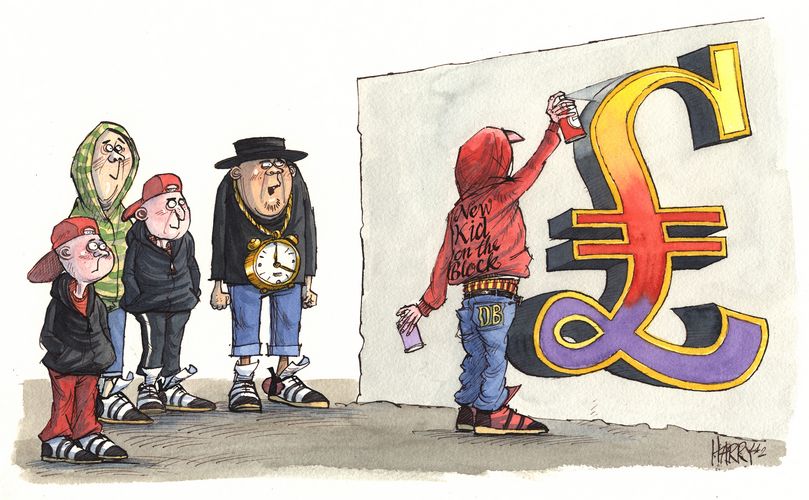New kid on the block: It has often been assumed that the top spot in the sterling market was the natural preserve of UK-based banks. Deutsche Bank showed this was not necessarily the case. It brought new and rare issuers to the currency and offered investors welcome diversification. Deutsche Bank is IFR’s Sterling Bond House of the Year.
To see the full digital edition of the IFR Review of the Year, please <a href="http://edition.pagesuite-professional.co.uk//launch.aspx?eid=24f9e7f4-9d79-4e69-a475-1a3b43fb8580" onclick="window.open(this.href);return false;" onkeypress="window.open(this.href);return false;">click here</a>.
While historically a market dominated by UK banks, the sterling primary sector saw a new power emerge in 2012 in the shape of Deutsche Bank.
The firm carved out a sizeable niche after years of creditable, if not eye-catching, performance, exploding on to the scene and grabbing the initiative from the erstwhile market leaders.
Deutsche located pockets of investor demand, as well as arbitrage opportunities for issuers, across the maturity spectrum, spotting the potential for diversification for both parties early on in the proceedings.
“For a non-UK bank to be doing this was remarkable,” said Frazer Ross, managing director of corporate debt syndicate at Deutsche. “It was actually a very international year in sterling, as in every other currency. It was a very global year.”
That helps explain Deutsche’s success in the sector, given that it maintains an open mind as far as currency is concerned and does not have any preconceived ideas as to who should do what where.
However, there are few, if any, banks within the upper echelons of the sterling league table that do not look across various markets. Deutsche’s success was all the more notable in the face of strong competition.
Top of the table
In the corporate realm, the bank asserted its position as a bookrunner of choice as early as December 2011, when it ushered Brazilian oil giant Petrobras to the market with a £700m 15-year transaction – the issuer’s first deal in the currency. And it built on this success with a follow-up 17-year deal in September as the company continued to diversify its funding across a number of currencies.
En route to the top of Thomson Reuters corporate sterling league table, the bank helped BMW bolster its fledgling curve with a £750m 2018 deal in February, recognising the opportunities created by a favourable move in the sterling-euro basis swap.
With Deutsche’s help, the German automaker commanded a sizeable £2.6bn of interest, around a third of which stemmed from Continental Europe. Many observers said that this paved the way for a similar deal from Daimler just days later.
The bank was also one of three leads on that seven-year £500m deal, which priced at Gilts plus 215bp, comfortably inside of guidance, on the back of a £1bn order book.
Other notable highlights of the year included acting as sole bookrunner on the £750m 30-year bond for America Movil in July. That was the first time that the Latin American telecoms had ever entrusted a single bank to execute an international bond deal and underlined the confidence it had in Deutsche’s sterling capabilities.
As well as being the largest bond ever priced by an emerging market issuer in sterling, it was also the longest dated.
In August, Deutsche was instrumental in pricing a dual-tranche combined £1bn 13 and 30-year bond for German engineering conglomerate Siemens. The coupons of 2.75% and 3.75%, respectively, set records for the currency in those maturities.
Crossing the pond
The bank added another string to its bow by bringing US credits to market. It was lead manager on AT&T’s fourth-biggest deal ever, a £1.25bn 32-year in May, taking advantage of the sterling market’s ability to offer longer-dated solutions. In June it priced a £650m 30-year bond for Time Warner Cable with officials familiar with the credit saying that by advising the corporate to choose sterling over US dollars, Deutsche helped it save around 43bp in pricing.
“Either you could get tenors you couldn’t get in Europe or you could save a significant number of basis points,” said Ross.
Deutsche also made various forays into the UK market on behalf of issuers like Transport for London, IFR’s Sterling Bond of the Year, (its £500m 30-year marking its first visit to the public debt markets since 2006, which in turn led to a £500m 10-year return a few weeks later, which was also led by Deutsche), Thames Water and Circle Anglia Social Housing.
In September, top US satellite TV provider DirecTV mandated Deutsche as one of two leads on its £750m 2029 debut. A series of fixed-income meetings across London and Edinburgh helped garner support in excess of £2bn.
Deutsche recognised that the spread in Libor terms at the 17-year part of the curve made the tenor particularly attractive compared with 15 or 20-year funding. That assumes, of course, that credit spreads versus Gilts are fairly constant at the longer end of the market.
A similar rationale was behind a dual-tranche seven-year euro and 17-year sterling bond that Deutsche helped execute for US biotechnology company Amgen.
The £700m part priced at 182bp over Gilts on a book of £1.8bn. Observers at the time particularly praised the timing of the deal, and the leads’ strategy of taking advantage of a relatively undersupplied sterling market.
Deutsche was also one of the arrangers on BG Group’s multicurrency €500m, £600m and US$500m hybrid – the first ever from a UK corporate.
Although several hybrids were priced in the wake of the BG deal, none matched its performance in the secondary market.
The three tranches, which all offered a coupon of 6.5%, were trading at cash prices of between 107.50 and 110.25 in mid-November, outperforming RWE’s, ArcelorMittal’s and SSE’s hybrid notes. Those were all trading at cash prices of between 102.25 and 108.00.
Early FIG strike
Deutsche demonstrated its prowess in the financials market almost as early as it did in corporates.
Again exploiting the favourable sterling/euro basis swap created by December 2011’s LTRO, on January 11 it lead managed a £400m seven-year fixed-rate deal for Svenska Handelsbanken, which it quickly followed up the following day with a similarly sized two-year FRN.
The Nordic theme was one that was evident at both ends of the year, with Deutsche also lead managing a £500m seven-year deal for Nordea in early November.
Although new issuance from the FIG sector was not a massive driving force throughout much of the year – for one thing, the UK banks’ priorities were centred on liability management, where Deutsche also played a key role in such exercises as Lloyds’ £13.8bn tender in June and its £22bn in September – there were some notable transactions on which it worked.
Not least among these was the £500m 17-year from Wells Fargo in September, which was the first sterling deal from a US financial for 18 months and the first from the issuer since 2007.
And marking something of a theme, MetLife sold a £500m 14-year GIC-backed deal the same month as part of a dual-currency euro/sterling exercise. While the euro tranche was the borrower’s first in that currency since 2007, the other was actually its first sterling transaction since 2006. Deutsche was a lead manager on both tranches.
In the SSA arena, the bank maintained its strong relationship with the UK DMO, acting as lead manager on three deals, including the first tap of the March 2062 index-linker (its longest in the market throughout the year), the tap of the July 2052 conventional issue and the launch of the new March 2044 linker.
While the bank was once again active from the very start of the year in this sector, with deals from the likes of KfW, the EIB, Rentenbank and EDC, it was perhaps the £1.5bn three-year from Network Rail that was most eye-catching.
The biggest non-Gilt SSA issue in the last three years and the issuer’s largest single transaction in more than a decade, it encountered such demand that it was tripled from the initially targeted amount of £500m – itself not necessarily a certainty given the turbulent environment – and priced at the tight end of guidance.
This success not only opened the market to other SSA borrowers but also paved the way for Network Rail to return the following month with a £500m tap of three tranches of index-linked paper, a sizeable amount of such bonds to sell in one shot away from the Gilt market.



